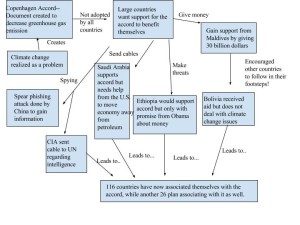1.)
2.) For my diagram, I wanted to focus on the interactions between the cables, climate change, and their effect on gaining support for the Copenhagen Accord. The article describes how large countries such as the United States wanted the accord to be officially adopted as it encourages each nation to focus on a way to reduce greenhouse gases. As a result, it allows for easier access to bind to rapidly growing countries than the process proposed by the United Nations. So, I started my diagram by explaining how climate change encouraged the creation of the Copenhagen Accord. Many countries did not support the accord, so it pushed the U.S. to find ways to gain their approval of it. I decided to break down the different ways the U.S. fought to change the opinions of these countries. They used spying, cables, money, and threats to encourage countries to join the Copenhagen Accord. There were several countries mentioned throughout the article, so I decided to group them based on how their opinions were manipulated by the U.S. (Saudi Arabia, Ethiopia, Maldives, and others). Finally, each country involved in the accord must commit to some change within their country to reduce greenhouse gases. Many countries agreed to make a change, so I tied the entire diagram together by showing how over one hundred and sixteen countries decided to support the accord. Another twenty-six countries plan on committing to the accord later in time as well. The various means of encouraging support performed by the United States seemed to have worked!
3.) After reading the article, I believe the cable leak makes climate change collective action more difficult than before. Collective action in terms of climate change requires groups to make a change together to reduce emissions, even though the individual might want to emit more gasses. The article discusses America’s means of bribing other countries to support the accord, including giving countries financial aid. Many countries might not want to change or reduce their emissions, but they are doing it for the money. As soon as the money is removed, the country might stop their efforts to save the environment. It is similar to the idea of carbon offsetting! Companies pay people to reduce their emissions. Yet, people may need money to motivate them to reduce their carbon footprint on their own. Countries and individuals need to find it in themselves to reduce emissions because it can affect the future of our world. They need to realize climate change creates issues with plant life and how they adapt to rising temperatures, rising water levels due to melting, and even humans! So, they should voluntarily want to help and not be manipulated by our country to do so. It may have been frustrating for the United States to see other countries not willing to support the accord. Yet, I do not think it is right to force countries through threats to agree to it. Conversations about why they would not agree or what they believe should be done might have been more successful than manipulation of their beliefs. Allowing for countries which are near each other to have conversations about what they can do to decrease greenhouse emissions might be easier than having the whole world try to communicate. It might allow for countries nearby to work with one another to mitigate the effects of climate change in their area.


Hi Amanda, my name is Caren. Feel free to check out my blog!
http://geog030.dutton.psu.edu/2016/04/04/climate-diplomacy-2/
I found your blog interesting because it addressed all the issues in the article. I like how you mentioned all the different countries within your system diagram. I also found it interesting how you created your system diagram to have a more positive view on the US WikiLeaks cables. I also mentioned in my blog how the US state department shouldn’t have bribed or threatened other countries into following the accord. It is important for other countries to communicate and listen to each other in order to create sustainability and achieve climate mitigation.
Hi Amanda! My name is Sara Getson, you can find my blog post here http://geog030.dutton.psu.edu/2016/04/04/climate-change-and-politics-sara-getson/. I thought your systems diagram was really well organized and easy to follow. Very thoughtful as well. With regard to the collective action problem, I’m not sure I would really say that the Leaks actually made the collective effort harder all by themselves. The main problem, as I see it, stems from the initial actions of the US to bribe these countries and communicate secretly. If this had not occurred, then any leak wouldn’t make a difference and in one way or another the truth would have won out anyway, I feel.